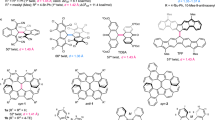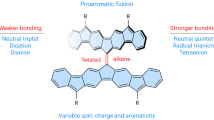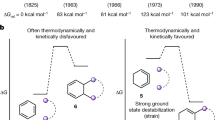Abstract
The highest-energy stereoisomer of 1,2,3,4,5,6-hexafluorocyclohexane, in which all of the fluorines are ‘up’, is prepared in a 12-step protocol. The molecule adopts a classic chair conformation with alternate C–F bonds aligned triaxially, clustering three highly electronegative fluorine atoms in close proximity. This generates a cyclohexane with a high molecular dipole (μ = 6.2 D), unusual in an otherwise aliphatic compound. X-ray analysis indicates that the intramolecular Fax···Fax distances (∼2.77 Å) are longer than the vicinal Fax···Feq distances (∼2.73 Å) suggesting a tension stabilizing the chair conformation. In the solid state the molecules pack in an orientation consistent with electrostatic ordering. Our synthesis of this highest-energy isomer demonstrates the properties that accompany the placement of axial fluorines on a cyclohexane and the unusual property of a facially polarized ring in organic chemistry. Derivatives have potential as new motifs for the design of functional organic molecules or for applications in supramolecular chemistry design.
This is a preview of subscription content, access via your institution
Access options
Subscribe to this journal
Receive 12 print issues and online access
$259.00 per year
only $21.58 per issue
Buy this article
- Purchase on Springer Link
- Instant access to full article PDF
Prices may be subject to local taxes which are calculated during checkout






Similar content being viewed by others
References
Fier, P. S. & Hartwig, J. F. Selective C–H fluorination of pyridines and diazines inspired by a classic amination reaction. Science 342, 956–960 (2013).
Müller, K., Faeh, C. & Diederich, F. Fluorine in pharmaceuticals: looking beyond intuition. Science 317, 1881–1886 (2007).
Kirsch, P. Modern Fluoroorganic Chemistry: Synthesis, Reactivity, Applications 2nd edn (Wiley-VCH, 2013).
O'Hagan, D. Understanding organofluorine chemistry. An introduction to the C–F bond. Chem. Soc. Rev. 37, 308–319 (2008).
Biffinger, J. C., Kim, H. W. & DiMagno, S. G. The polar hydrophobicity of fluorinated compounds. ChemBioChem 5, 622–627 (2004).
Burns, M. et al. Assembly-line synthesis of organic molecules with tailored shape. Nature 513, 183–188 (2014).
Hunter, L., Kirsch, P., Slawin, A. M. Z. & O'Hagan, D. Synthesis and structure of stereoisomeric multivicinal hexafluoroalkanes. Angew. Chem. Int. Ed. 48, 5457–5460 (2009).
Barton, D. H. R. The conformation of the steroid nucleus. Experientia 6, 316–320 (1950).
Durie, A. J., Slawin, A. M. Z., Lebl, T., Kirsch, P. & O'Hagan, D. Synthesis and structure of all-syn-1,2,3,4-tetrafluorocyclohexane. Chem Commun. 47, 8265–8267 (2011).
Durie, A. J., Slawin, A. M. Z., Lebl, T., Kirsch, P. & O'Hagan, D. Fluorocyclohexanes: synthesis and structure of all-syn-1,2,4,5-tetrafluorocyclohexane. Chem Commun. 48, 9643–9645 (2012).
Durie, A. J., Slawin, A. M. Z., Lebl, T. & O'Hagan, D. The synthesis of η-1,2,3,4,5,6-hexafluorocyclohexane (benzene hexafluoride) from benzene. Angew. Chem. Int. Ed. 51, 10086–10088 (2012).
Luo, Q., Randall, K. R. & Schaefer, H. F. Easy chairs: the conformational preference of polyfluorinated cyclohexanes. RSC Adv. 3, 6572–6585 (2013).
Zdravkovski, Z. Theoretical study of the stability of hexachloro- and hexafluorocyclohexane isomers. Bull. Chem. Technol. Macedonia 23, 131–137 (2004).
Ogawa, S., Oki, S. & Suami, T. Inositol derivatives. 11. Synthesis of dianhydroinositols. Bull. Chem. Soc. Jpn 52, 1095–1111 (1979).
Lal, G. S., Pez, G. P., Pesaresi, R. J. & Prozonic, F. M. Bis(2-methoxyethyl)aminosulfur trifluoride: a new broad-spectrum deoxofluorinating agent with enhanced thermal stability. Chem. Commun. 215–216 (1999).
Middleton, W. J. New fluorinating reagents. Dialkylaminosulfur fluorides. J. Org. Chem. 40, 574–578 (1975).
Beaulieu, F. et al. Aminodifluorosulfinium tetrafluoroborate salts as stable and crystalline deoxofluorinaing reagents. Org. Lett. 11, 5050–5053 (2009).
Schmidt, M. W. et al. General atomic and molecular electronic structure system. J. Comput. Chem. 14, 1347–1363 (1993).
Gordon, M. S. & Schmidt, M. W. in Theory and Applications of Computational Chemistry. The First Forty Years (eds Dykstra C. E., Frenking G., Kim K.S. & Scuseria, G. E.) Ch. 41 (Elsevier, 2005).
Dunitz, J. D. Organic fluorine: odd man out. ChemBioChem 5, 614–621 (2004).
Kashtiban, R. J. et al. Atomically resolved imaging of highly ordered alternating fluorinated graphene. Nature Commun. 5, 4902 (2014).
Sahin, H., Topsaka, M. & Ciraci, S. Structures of fluorinated graphene and their signatures. Phys. Chem. Rev. B 83, 115432 (2011).
Goodman, L., Gu, H. & Pophristic, V. Gauche effect in 1,2-difluoroethane. Hyperconjugation, bent bonds, steric repulsion. J. Phys. Chem. A 109, 1223–1229 (2005).
Perrin, C. L. & Dwyer, T. J. Application of two-dimensional NMR to kinetics of chemical exchange. Chem. Rev. 90, 935–967 (1990).
Anet, F. A. L. & Bourn, A. J. R. Nuclear magnetic resonance line-shape and double-resonance studies of ring inversion on cyclohexane-d11 . J. Am. Chem. Soc. 89, 760–798 (1967).
Badenhoop, J. K. & Weinhold, F. Natural bond order analysis of steric interactions. J. Chem. Phys. 107, 5406–5421 (1997).
Glendening, E. D., Landis, C. R. & Weinhold, F. NBO 6.0: Natural bond orbital analysis program. J. Comput. Chem. 34, 1429–1437 (2013).
Reed, A. E., Curtiss, L. A. & Weinhold, F. Intermolecular interactions from a natural bond orbital, donor–acceptor viewpoint. Chem. Rev. 88, 899–926 (1988).
Weinhold, F. & Landis, C. R. Valency and Bonding: A Natural Bond Orbital Donor–Acceptor Perspective (Cambridge Univ. Press, 2005).
Nelson, R. D., Lide, D. R. & Maryott, A. A. Selected Values of Electric Dipole Moments for Molecules in the Gas Phase (National Standards Reference Data Series 10, National Bureau of Standards, 1967).
Haynes, W. M. CRC Handbook of Chemistry and Physics 95th Edn, Section 9-15 (CRC Press, 2014).
Kawai, H. The piezoelectricity of poly (vinylidine fluoride). Jpn J. Appl. Phys. 8, 975–976 (1969).
Patrick, C. R. & Prosser, G. S. A molecular complex of benzene and hexafluorobenzene. Nature 187, 1021 (1960).
Williams, J. H., Cockroft, J. K. & Fitch, A. N. Structure of the lowest temperature phase of the solid benzene–hexafluorobenzene adduct. Angew. Chem. Int. Ed. 31, 1655–1657 (1992).
Acknowledgements
This work was supported by the Engineering and Physical Sciences Research Council (EPSRC) and the European Research Council (ERC). D.O'H. thanks the Royal Society for a Wolfson Research Merit Award. The authors acknowledge the EPSRC National Mass Spectrometry Facility (Swansea) for analytical assistance.
Author information
Authors and Affiliations
Contributions
N.K. and D.O'H conceived the synthesis of 1. N.K. designed the synthetic route and performed all of the synthesis and standard characterization. A.M.Z.S. obtained and solved the crystallographic data. T.L. conducted the low-temperature EXSY NMR studies and analysed the data. D.P. carried out the density functional theory and NBO theory studies. The manuscript was co-written by N.K. and D.O'H. All authors discussed the results and commented on the manuscript.
Corresponding author
Ethics declarations
Competing interests
The authors declare no competing financial interests.
Supplementary information
Supplementary information
Supplementary information (PDF 24174 kb)
Supplementary information
Crystallographic data for compound 1 (CIF 88 kb)
Supplementary information
Crystallographic data for compound 3 (CIF 268 kb)
Supplementary information
Crystallographic data for compound 5 (CIF 599 kb)
Supplementary information
Crystallographic data for compound 7 (CIF 128 kb)
Supplementary information
Crystallographic data for compound 8 (CIF 242 kb)
Supplementary information
GAMESS-US output for electronic structure calculation performed on Compound 1 at the M11/6-311G(2d,p) level of theory (TXT 2119 kb)
Supplementary information
NBO6 .47 archive file for Compound 1 (TXT 8640 kb)
Supplementary information
Output file from NBO analysis of Compound 1 (TXT 1854 kb)
Rights and permissions
About this article
Cite this article
Keddie, N., Slawin, A., Lebl, T. et al. All-cis 1,2,3,4,5,6-hexafluorocyclohexane is a facially polarized cyclohexane. Nature Chem 7, 483–488 (2015). https://doi.org/10.1038/nchem.2232
Received:
Accepted:
Published:
Issue Date:
DOI: https://doi.org/10.1038/nchem.2232
This article is cited by
-
Lateral dipole moments induced by all-cis-pentafluorocyclohexyl groups cause unanticipated effects in self-assembled monolayers
Nano Research (2023)
-
Living supramolecular polymerization of fluorinated cyclohexanes
Nature Communications (2021)
-
Theoretical study of electronic and nonlinear optical properties of Janus all-cis-1,2,3,4,5,6-hexafluorocyclohexane derivative with an extended π conjugation
Theoretical Chemistry Accounts (2020)
-
A Chiron approach towards the stereoselective synthesis of polyfluorinated carbohydrates
Nature Communications (2018)
-
A practical and catalyst-free trifluoroethylation reaction of amines using trifluoroacetic acid
Nature Communications (2017)



